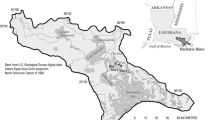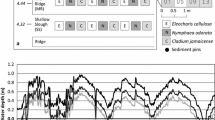Abstract
The effect of transplant spacings (45, 60, and 90 cm) on establishment ofSpartina alterniflora along an eroding shoreline in North Carolina was evaluated and annual biomass production of the planted marsh was compared to a natural marsh. The 45- and 60-cm spacings were more successful for establishment on marginal sites that were near the lower elevation limits ofS. alterniflora. The 90-cm spacing was adequate where growing conditions were favorable. Measurements of aboveground growth indicated that there were no differences due to spacing by the end of the second growing season. Differences between spacing treatments in belowground dry weight persisted through three growing seasons. Annual aboveground and belowground standing crop of the transplanted marsh and a nearby natural marsh were compared over a ten-year period. During the early years of development, several characteristics of the transplanted vegetation differed from the natural marsh, but these differences diminished with time. Development of the aerial portion of the transplanted vegetation was rapid, with the most vigorous growth occurring in the second growing season. At that stage of development, the transplants were taller with more flowering stems and a greater standing crop. There were fewer but larger stems than in later years or in the natural marsh. Belowground standing crop increased over the first 3 growing seasons, reached an equilibrium level in 4 growing seasons, and remained constant during the remainder of the study. This indicated that annual production and decomposition of belowground material were about equal. Annual belowground production was estimated to be about 1.1 times the October standing crop of aboveground material. The results indicated that vegetation in a man-initiatedS. alterniflora marsh was effective in reducing shoreline erosion and was comparable to a natural marsh growing under similar environmental conditions. The ten-year sampling period was adequate to document that the transplanted marsh was equal in primary productivity and that it was persistent and self-sustaining.
Similar content being viewed by others
Literature Cited
Broome, S. W., W. W. Woodhouse, Jr., andE. D. Seneca. 1975. The relationship of mineral nutrients to growth ofSpartina alterniflora in North Carolina: II. The effects of N, P, and Fe fertilizers.Soil Sci. Soc. Am. Proc. 39:301–307.
Broome, S. W., E. D. Seneca, andW. W. Woodhouse, Jr. 1983. Planting marsh grasses for erosion control. UNC Sea Grant College Publication UNC-SG-81-09. UNC Sea Grant College Program, North Carolina State University, Raleigh, 11 p.
Broome, S. W., E. D. Seneca, andW. W. Woodhouse, Jr. 1983. Creation of brackish-water marsh habitat, p. 319–338.In D. J. Robertson (ed.), Proceedings of the Symposium, Reclamation and the Phosphate Industry. Florida Institute of Phosphate Research, Bartow.
de la Cruz, A. A. 1973. The role of the tidal marshes in the productivity of coastal waters.Assoc. Southeastern Biol. Bull., 20:147–156.
Dodd, J. D., andJ. W. Webb. 1975. Establishment of vegetation for shoreline stabilization in Galveston Bay. MP 6-75, U.S. Army Corps of Engineers, Coastal Engineering Research Center, Fort Belvoir, 67 p.
Knutson, P. L. 1977. Planting guidelines for marsh development and bank stabilization. Coastal Engineering Technical Aid No. 77-3. Coastal Engineering Research Center, Fort Belvoir, 21 p.
Knutson, P. L., R. A. Brochu, W. N. Seelig, andM. Inskeep. 1982. Wave damping inSpartina alterniflora marshes.Wetlands 2:87–104.
Lugo, A. E., and M. M. Brinson. 1979. Calculations of the value of salt water wetlands, p. 120–130.In P. E. Greeson, J. R. Clark, and J. E. Clark (eds.), Wetland Functions and Values: The State of Our Understanding. Proceedings of the National Symposium on Wetlands, American Water Resources Association, Minneapolis.
Odum, W. E., andS. S. Skjei. 1974. The issue of wetlands preservation and management: a second view.Coastal Zone Management 1:151–163.
Race, M. S., andD. R. Christie. 1982. Coastal zone development: mitigation, marsh creation and decision making.Environ. Management 6:317–328.
SAS User’s Guide: Basics. 1982. SAS Institute, Incorporated, Cary, 921 p.
Steel, R. G. D., andJ. H. Torrie. 1960. Principles and procedures of statistics. McGraw-Hill Book Company, Inc., New York, 481 p.
Sullivan, M. J., andF. C. Daiber. 1974. Response in production of cord grass,Spartina alterniflora, to inorganic nitrogen and phosphorus fertilizer.Chesapeake Sci. 15:121–123.
Turner, R. E. 1976. Geographic variation in salt marsh macrophyte production: a review.Contrib. Mar. Sci. 20:47–68.
Valiela, I., andJ. M. Teal. 1974. Nutrient limitation in salt marsh vegetation, p. 547–563In R. J. Reimold and W. H. Queen (eds.), Ecology of Halophytes. Academic Press, New York.
Woodhouse, W. W., Jr.,E. D. Seneca, andS. W. Broome. 1976. Propagation and use ofSpartina alterniflora for shoreline erosion abatement. Tech. Report No. 76-2, U.S. Army Corps of Engineers, Coastal Engineering Research Center, Fort Belvoir, 72 p.
Author information
Authors and Affiliations
Additional information
Paper No. 9984 of the Journal Series of the North Carolina Agricultural Research Service, Raleigh, North Carolina 27695-7601.
The use of trade names in this publication does not imply endorsement by the North Carolina Agricultural Research Service of the products named, nor criticism of similar ones not mentioned.
Rights and permissions
About this article
Cite this article
Broome, S.W., Seneca, E.D. & Woodhouse, W.W. Long-term growth and development of transplants of the salt-marsh grassSpartina alterniflora . Estuaries 9, 63–74 (1986). https://doi.org/10.2307/1352194
Received:
Accepted:
Issue Date:
DOI: https://doi.org/10.2307/1352194




